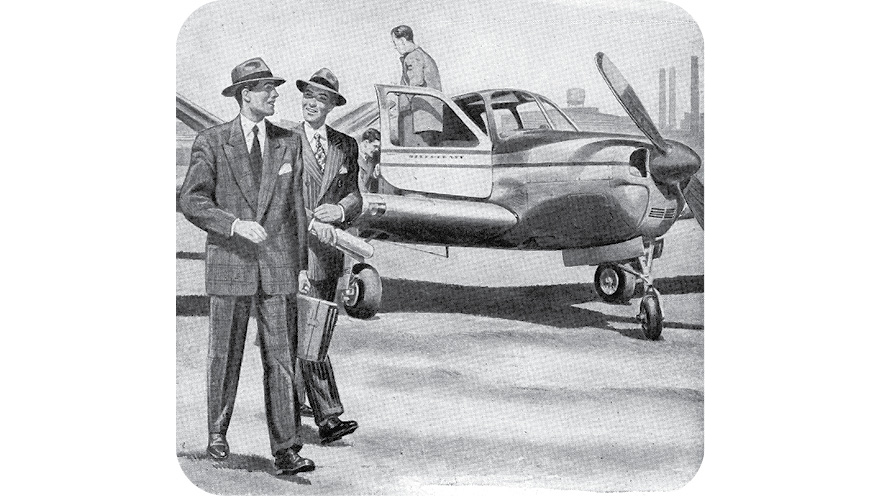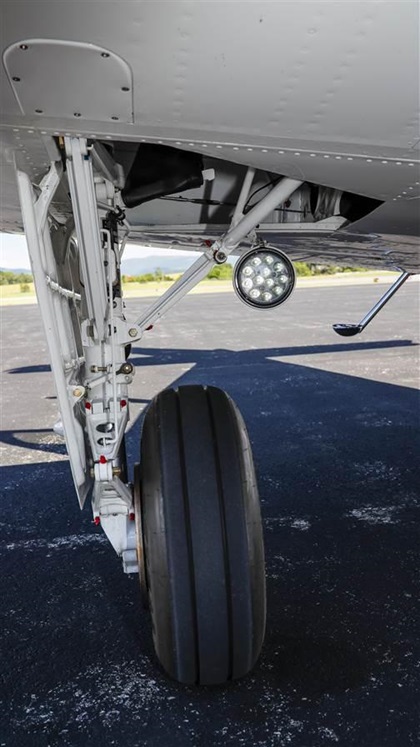Timeless beauty
In praise of the Beechcraft Bonanza

Bonanzas are well built. A late-model stock Bonanza may operate in the utility category with up to 4.4 positive Gs and 1.76 negative Gs. That’s manifested in extra casting and forging thickness.
The landing gear is stout. It allows routine operation off grass strips that are less than golf-green perfect. The basic design was tested decades ago when Beech was building T–34s for the U.S. Navy.
The gear doors completely cover tires and wheel wells while some others only cover the strut. As Beech improved the models over the years, the operating speed for gear and flaps increased. On later aircraft, landing gear and approach flaps can be lowered at cruise speed to descend quickly or slow down, making slam dunk arrivals much easier.
Bonanzas have a hinged cowl for easy access to the upper two thirds of the engine. Oil changes, upper spark plug inspections, and fuel injector access are easy.
The wing isn’t as sleek as a Mooney or a Cirrus, but it’s shaped to do everything well. It’s reasonably fast in cruise with slow landing speeds.






The later A36s have an odd-shape wedge on the outboard leading edge. Legend states it’s there to hold the pilot’s beer can during preflight. Less colorfully, it’s a vortex generator that dampens the wing drop tendency that earlier Bonanzas exhibit during stalls with flaps extended. It was developed to allow the turbocharged Bo to meet FAA spin recovery requirements.
The cockpit door on Bonanzas is a study in over-engineering. It has a complex internal mechanism, and when something fails from old age or misuse, it will require an expensive fix.
The A36 rear doors are robust and simple with an annunciator that notes if it’s not properly latched. Passengers with mobility issues are easily accommodated. The rear doors can be removed for aerial photography. Two over-wing window exits can be used for ground ventilation or emergency egress. Practical and smart.


Aft-facing mid-seats provide first-class leg room and there’s room for plenty of luggage.The long-body A36 was developed in response to Cessna’s 210/Centurion and Cessna 206, which could carry more with a much wider center of gravity window. Beech’s initial idea was to push into the air taxi market but that didn’t work. Luggage with six aboard? Fuhgeddaboudit! If you’re regularly carrying five or six people, range will be severely limited. Four seats were enough for my needs and removing the two rear seats lowered my insurance premium significantly. Aft-facing mid-seats provide first-class leg room and there’s room for plenty of luggage.
Seventy-four usable gallons provides roughly 5.4 hours on full tanks when running at 65 percent and lean of peak. Beech uses a simple and precise measuring system with a calibrated tab. At the slots, there are eight gallons less and at bottom of the tab, the flight can carry an additional 84 pounds, which sacrifices an hour of endurance. Adding tip tanks creates a 350-pound gross weight increase because of reduced span loading but it also moves the aircraft back to normal category and results in minor decreases in performance.
The throwover yoke that made flight instruction more exciting in earlier models but provided a nonpilot right seat passenger with more room was removed. Dual controls became standard, and Beech raised the height of the panel several inches. That reduced the excellent forward visibility that Bonanzas enjoyed for decades to make room for more avionics.

The Bo has smooth controls in all axes. Newer models are heavier in pitch but roll control is light which is both blessing and curse. I’ve found the aircraft to be stable in instrument conditions. For balance, runway handling, takeoff and landing distance, ease of boarding, and load carrying flexibility, the Bo excels.
Textron Aviation is not taking any more orders for Barons or Bonanzas after what is the longest uninterrupted production run of any general aviation aircraft. While they haven’t stated a reason, the margins apparently aren’t there even with a list price of more than $1 million. What’s needed are some investors/entrepreneurs who’d like to follow the time-honored aviation path of making a small fortune out of a large one and buy out the line. With a great marketing team, low overhead, and some sharp engineers, minor improvements could be made to what is one of the finest aircraft ever built. Realistic pricing is part of the equation.
Happily, for owners, well-maintained and updated Bonanzas hold their value and most appreciate. Mark Twain was to have said, “Buy land, they ain’t makin’ it anymore.” Sadly, the same may be said about Bonanzas. 
Bruce Landsberg is the owner of a 1987 Beechcraft Bonanza A36.



